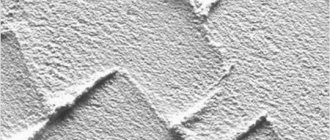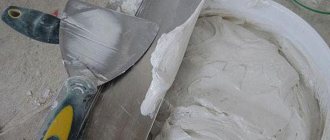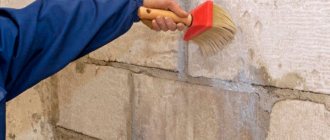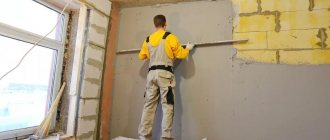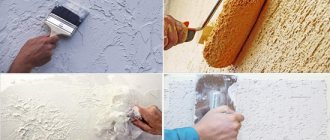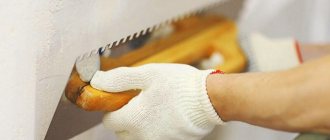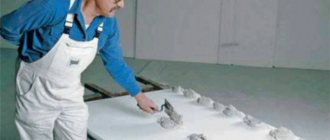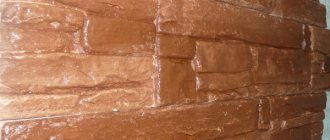Why plaster foam blocks inside the house
Building structures made of foam blocks require finishing. Plaster is used to seal the seams between the elements, give a smooth surface to which wallpaper is glued, decorative plaster or paint is applied.
Plastering improves the performance of products:
- improves thermal insulation properties;
- protects against temperature changes;
- prevents moisture absorption.
Foam blocks are cellular concrete, which easily absorb water and cause dampness in the room. This is especially true in areas with a humid climate.
Exterior view of an unplastered wall Source postroystenu.ru
Plastering foam concrete with your own hands - tips
Finishing a house made of foam blocks with plaster is carried out according to the standard scheme, but is somewhat different from plastering aerated concrete or brick. The difference is not significant, but it is there. Therefore, let’s look at the distinctive features.
When is it possible/needed to plaster a house made of foam blocks?
Finishing with plaster is carried out in dry weather, only at positive temperatures (from +5 to + 30 ° C). You can start plastering no earlier than 3-4 months (ideally a year) after the completion of construction of a house made of foam blocks. During this time, the walls will shrink.
Preliminary preparation of walls
Walls made of foam blocks do not need leveling, as they form a smooth surface. However, such a structure has poor adhesion to the subsequent finishing coating. To increase the absorbent effect, use the following solutions:
- Cover the walls with special primers or concrete-contact composition. These building mixtures penetrate the body of the foam block, some of them form a surface rough layer that provides adhesion to the plaster.
- Fastening the reinforcing element. Usually these are meshes made of metal or polymer materials, secured to the block with nails, glue, or dowels. The reinforcing element helps to bond the plaster to the surface of the foam block walls.
Experienced builders recommend using polymer mesh; this solves two problems - they eliminate the appearance of rust stains on the walls due to the formation of metal corrosion, and the ability to save money, since polymer meshes are cheaper.
Surface preparation Source sakh.com
Application technology
The process of treating foam blocks with plaster is not much different from other surfaces. And if you comply with a number of conditions, the surface will turn out even and smooth.
- First of all, the walls are primed. All further work depends on the initial surface treatment, which does not tolerate inaccuracies. If the priming step is done incorrectly, the plaster will need to be completely redone. The primer is the basis for further work and is applied in two layers.
Using mesh to reinforce the plaster layer.
The next step is to use reinforcing mesh to improve adhesion. The first layer is applied, into which the mesh is pressed. The solution is applied over the mesh. For sawn blocks, a mesh is not needed; it is used in difficult areas - under windows, in corners.- After the preparatory work, we begin applying the plaster mixture to the foam concrete. You can prepare it yourself by taking the ingredients in the right proportions, or buy it at a hardware store. Simply by diluting with water, you get the required consistency of the solution. Using a spatula, apply it to the walls in small portions and level it out.
- The dried layer is processed and leveled with a thin finishing layer.
- The final stage is painting the surface. They use special façade silicate paints and silicone-based paints.
Return to contents
How to plaster wall blocks inside a house
When choosing what to plaster foam blocks with, you should remember that you cannot use building mixtures intended for other building structures. The plaster needs to be light and should have maximum adhesion.
The following brands of this type are offered on the market:
- “Win” series, Egida TM-35 brand. Designed for working with foam concrete inside and outside the building.
- "Decor" Ш-36. The composition uses cement with elements of synthetic fiber, which is a reinforcing link. The plaster is easy to apply by hand and adheres well to foam concrete.
- Ceresit CT24. It has been used for a long time and successfully due to its excellent qualities and low price.
- Glims Velur. Perlite plaster mixture for finishing surfaces made of cellular concrete, fits well, does not crack over time, applied in 2-3 layers.
Products from manufacturers EuroMix, Ceresit, Belgips Best plaster, PROFIT Contact MN are widely used. They are characterized by high adhesion, ensuring reliable adhesion of foam concrete and plaster. Used for work outside and inside the building.
Plaster mixtures for foam blocks are sold ready-to-use or in the form of a dry powder Source stroy-gazobeton.ru
See also: Popular designs for bathhouses made of foam concrete blocks.
Conclusion
To plaster walls made of foam blocks, it is necessary to use only permeable materials that can reliably protect the walls from the effects of negative factors both outside and inside the room.
If everything is done efficiently and in accordance with the developed technologies, then you will only have to occasionally seal small cracks and periodically restore the color of the paint.
Rules for plastering foam blocks
To explain how to plaster a wall made of foam blocks with your own hands, let’s focus on the important nuances of the process:
- it is necessary to observe the temperature regime, plastering is performed when the outside air temperature reaches +5 degrees, its maximum value is +30 °C;
- when using polymer mixtures, it is allowed to reduce the thickness of the layer, while taking into account the requirements of the instructions for the material;
- as a finishing coating it is permissible to apply plaster with the addition of dye to it; it is possible to purchase ready-made multi-colored mixtures;
- Galvanized mesh is used as a reinforcing element to prevent the appearance of rusty stains on plastered walls.
Between finishing stages it is important to observe the breaks required by the technological processes. Leave each layer until completely dry before applying the next one.
Plastering walls using beacons Source harthaus.ru
Indoor plastering technology
Let's consider the process of how to properly plaster walls made of foam blocks indoors. Perform the following types of work:
- Clean block walls from dirt and rust stains.
- Degrease the surface with solutions, such as a soda solution or a sewer pipe cleaner diluted with water.
- Apply the primer with a sprayer, brush, or roller. The work is carried out in 2-3 stages, waiting for the previous layer of soil to dry. This number of layers is required to impregnate the surface of the foam block and provide better adhesion to the plaster.
- Fix the reinforcing mesh. For the metal version, dowels are used. The plastic mesh is fixed using a solution or special glue. For walls inside the building and partitions, fiberglass material with a small cell, which is glued to the surface of the foam block, is suitable.
- When applying a thick layer of plaster, beacons are installed to obtain a flat surface.
- The solution is spread onto the surface with a trowel and leveled.
- After the plaster has dried, the walls are re-leveled, sagging and excess mortar are removed.
Laying reinforcing mesh Source yandex.net
See also: Catalog of companies that specialize in finishing materials.
When plastering internal walls made of foam blocks, a layer thickness of 10 mm is sufficient. After it has completely dried (the time is indicated in the instructions for using the mixture), a primer is applied, then the surface is finished.
Features of the work
Foam block is a capricious material, characterized by a porous structure. Porosity makes the material light and economical, but also complicates the application of plaster. not any mixture containing sand and cement may be suitable for wall treatment. As a result, the applied layer may fall off.
Blocks are made using two technologies:
Foam concrete, in the production of which the casting method was used.
The foundry method involves the production of blocks in a special form. The material does not come out on a very smooth surface, with low adhesion. To improve setting, reinforcing mesh and mixtures that increase adhesion are used. Before starting work, preparation is carried out: sanding or cleaning to remove the top layer.- The sawing method is characterized by casting a large mass and cutting off parts of the required size. Blocks obtained using this technology are better processed.
Compliance with small nuances will make working with foam concrete easier:
- Maintaining temperature conditions. The surface should not be cold, the wall temperature should not be lower than 5 degrees Celsius, but not higher than 30.
- Surface humidity. Dry foam blocks quickly absorb water, which negatively affects the drying process of the plaster layer.
Return to contents
Technology for plastering external walls made of foam blocks
The need to finish the surface of structures made of cellular concrete was mentioned earlier; then we will consider how to properly plaster foam block walls on the outside of a building. The outer walls of the building are exposed to precipitation, dust particles and gases from the surrounding air, and temperature differences between seasons. The negative influence of the environment leads to the destruction of blocks, loss of appearance, and moisture penetration into the walls.
Vapor-permeable materials are used for finishing external walls. The same compositions as for interior plaster are suitable; some mixtures are universal. The following work is carried out step by step:
- cleaning and degreasing the surface of blocks;
- applying a primer;
- laying reinforcing mesh;
- plastering;
- finishing.
Determining the evenness of walls and plaster Source vse-otoplenie.ru
Features of plastering foam block surfaces - tips and recommendations
Professional finishers recommend paying attention to the following points when performing plastering work:
- ambient temperature. It is advisable to plaster at positive temperatures from 6 to 28 degrees Celsius;
- thickness of the facade and internal layers of plaster. The outer coating should be twice as thick as the inner one;
- the need to moisten the foam concrete surface with water. In the hot season, moisture prevents cracking of the plaster;
- quality of finishing mixtures. Use plastering compounds from trusted manufacturers and follow the manufacturer's instructions.
Remember that plastering of foam block walls should be done no earlier than 30 days after the construction of the building frame. Please also pay attention to the thickness of the interior trim, which should not exceed 1-1.5 cm.
Despite its apparent simplicity, finishing a foam block surface is a responsible operation. You should choose what to plaster the walls with, study the technology in detail and master the techniques of working with construction tools. Professionally applied plaster will provide reliable protection for walls for a long time.
Plastering materials
When deciding how to plaster foam blocks outside the house, they choose materials with the following characteristics: they must be resistant to high positive and negative temperatures, humidity, and vapor permeable. An important characteristic is high adhesion to the smooth surface of the foam block.
Primers for cellular concrete use deeply penetrating materials, these are BOLARS, Knauf materials. Plastering is carried out using PROFIT Contact, Ceresit, Knauf Rotband, Winder materials. These mixtures are suitable for external and internal plastering.
Plastering on the outside is done after the walls have been thermally insulated. Foam blocks themselves can be insulation, but cold bridges form at the joints, which leads to the appearance of condensation and moisture on the walls.
Mixtures for plaster Source sevparitet.ru
Features of plastering foam blocks
To decide how to plaster foam blocks indoors, you should remember the concept of “dew point”. This place where condensation forms when cold air penetrates the wall structure is located between the plaster and the edges of the block from the inside. To prevent the appearance of condensation, maintain a proportional ratio of the thickness of the plaster layers. The thickness of the inner and outer layers should correspond to the value 1:2. A good solution would be to insulate external walls.
According to experts, the required thickness of the plaster layer on the facade is 5-10 mm; for the interior coating this value is 10-20 mm. The next layer is doubled in size compared to the previous one.
When installing external insulation for walls made of foam blocks, plastering inside the room is performed to level the surface for finishing or wallpaper. In any case, the use of a primer is mandatory.
Applying the final layer of plaster Source gidpoplitke.ru
The best way to plaster a foam block
Before plastering the foam blocks, you should select the appropriate mixture for the base. Take into account the place where the work will be carried out (street or room). The wrong choice of finishing material will reduce the performance properties of the base.
Plasters are:
- for rough work;
- specialized (soundproofing, barite, waterproofing, noise-reducing);
- decorative.
Depending on the binders, the finishing material can be:
- Mineral. The base is gypsum or cement. It has a low cost. Often used for rough finishing.
- Acrylov. The material is plastic and durable. They are easy to work with, so they are often used when creating decor. It is resistant to moisture and has high adhesive properties.
- Silicate. Well suited for facade decoration, because... durable and water-repellent. After application it sets quickly.
- Silicone. An expensive product that has good performance properties. Silicone plaster is durable and elastic. It repels moisture, but is vapor permeable.
Inside the house
For interior decoration, plaster is selected depending on which room will be renovated. If the foam block wall is located in conditions of high humidity, then waterproof compounds are a priority.
Example of waterproof compounds:
- cement or cement-polymer;
- silicone;
- acrylic.
In a room where the humidity level is low, you can use gypsum mixtures. When decorating a room, in addition to humidity, fire hazards are taken into account.
Therefore, not all mixtures can be used to decorate rooms, for example with a fireplace. If there is a fire source in the room, it is better to avoid acrylic plaster.
Outside the house
Plaster for foam blocks (external) must have increased strength. In order for the finishing material to last for a long time, it must be resistant to ultraviolet rays and temperature changes.
When choosing plaster for the facade of a building, you can choose silicate, cement (cement-lime), silicone or acrylic mixture.
Briefly about the main thing
The use of foam concrete in housing construction has contributed to the emergence of new technologies for finishing building structures. Deciding on the question of how to plaster the foam block outside or inside the house is quite simple in the presence of modern finishing materials. Building mixtures of the brands Ceresit, Knauf, PROFIT Contact and some others make it possible to obtain reliable wall coverings and protect against moisture penetration into the room.
It is important not to forget about following the sequence of work, to choose materials that are suitable in composition and do not cause chemical reactions upon contact. Plastering can be done yourself if you have certain skills in construction, but it is better to entrust it to specialists, because finishing is the first thing that catches your eye when entering the house.
Ratings 0
The right choice of finishing layer
When you decide to do the renovation yourself, you are faced with questions: how to choose the right finish, how to install it correctly. The mixture for plastering can be wet or dry, and according to its composition it is divided into:
- plaster;
- cement;
- limestone
Diagram of air and water penetration.
Let's look at each separately:
- The mixture with lime is used for interior work, as it does not tolerate rain. Inexpensive, environmentally friendly, easy to use. There is a minus - it is short-lived in use.
- Gypsum, which is part of the plaster, provides excellent sound insulation and heat protection. Gypsum has plasticity, so the mixture can easily be applied to all bases. There is no need to mix, just dilute with water according to the instructions. Compared to other types, it dries within a few hours and is resistant to cracking. The disadvantages include reduced resistance to moisture.
- Plaster, which contains cement, is suitable for interior and exterior finishing work. It has a long service life and gives shape to a variety of planes. It is important to ensure that the solution is prepared correctly; improper use can lead to cracking and shrinkage.
To get a positive result, it is important to remember the rules for diluting the mixture:
- study the instructions, ratios and offers may differ from different manufacturers;
- a modern dry mixture is gradually introduced into a container with liquid, but if the solution is based on cement, sand, lime, water is gradually introduced into the container where the dry components are prepared;
- the solution is mixed manually or using a construction mixer;
- the solution sets quickly, so you need to prepare it in small portions.
The special structure of the material requires specific finishing methods. Proper selection of a mixture with a suitable composition, preliminary preparation with a primer are necessary conditions for work. If all the nuances are observed and plastering is performed correctly, the protective finishing layer will look beautiful and will not fail in service.


